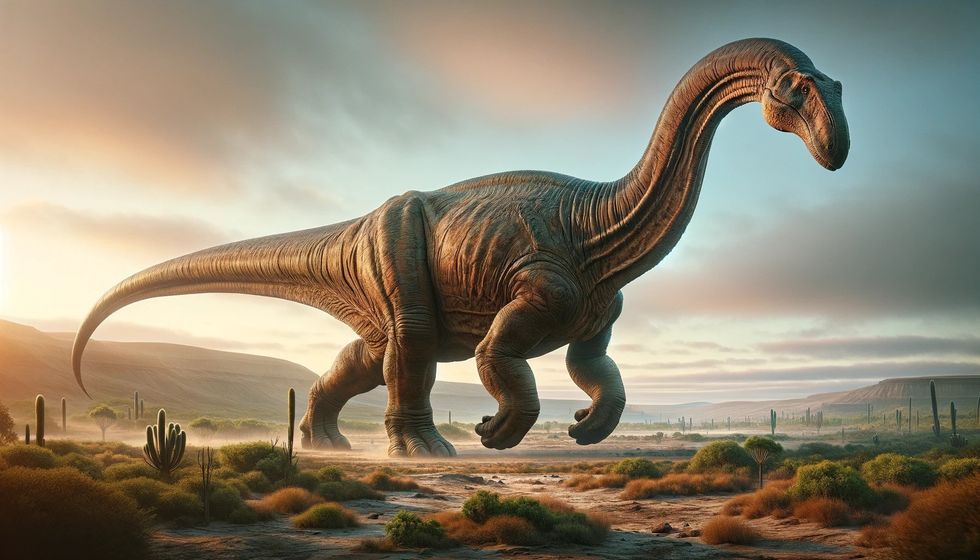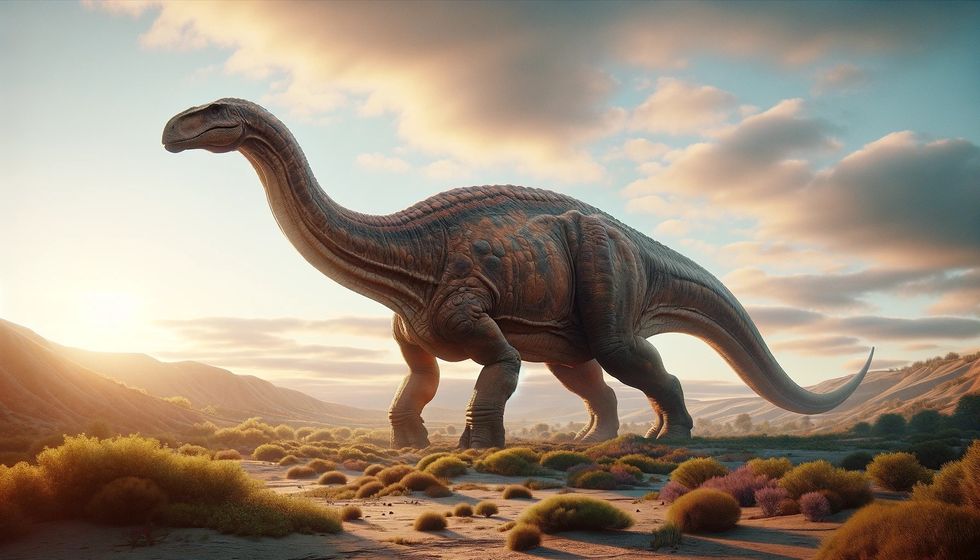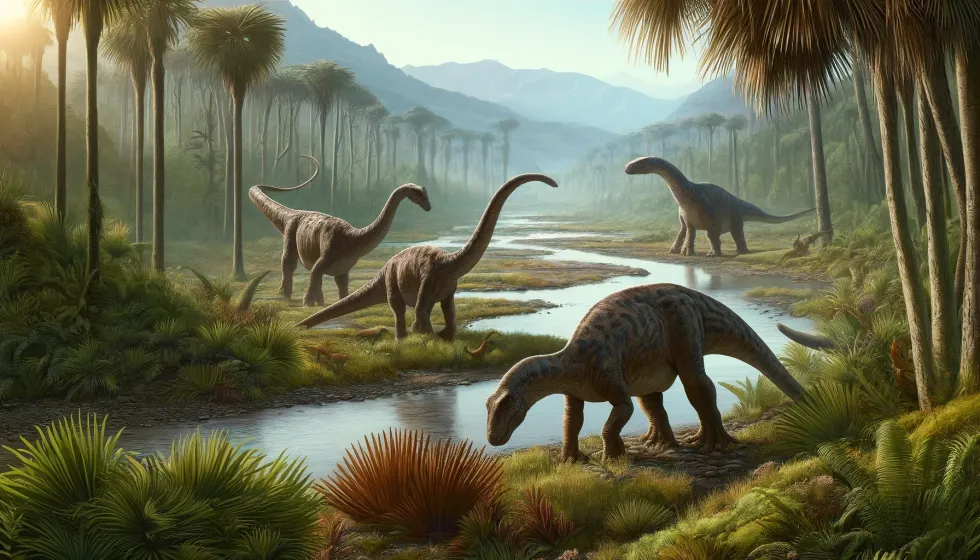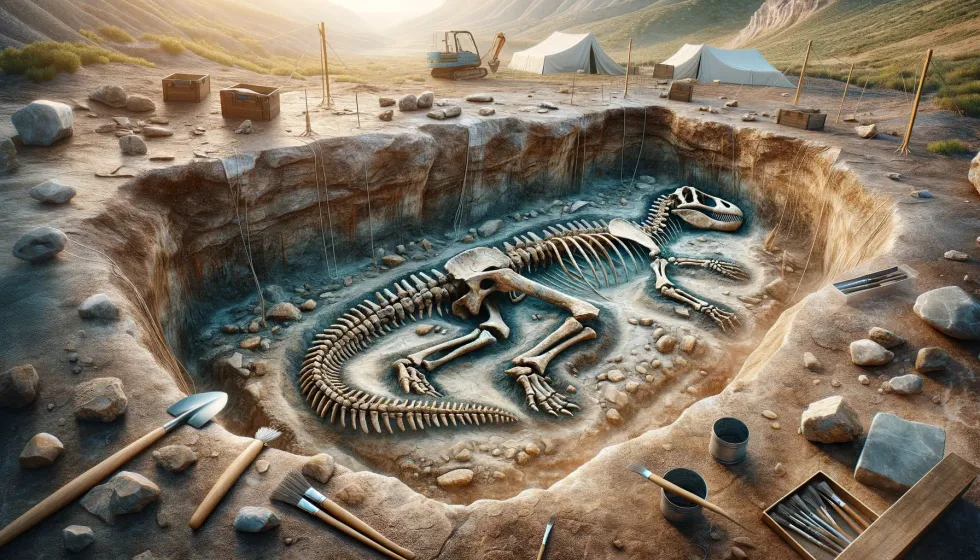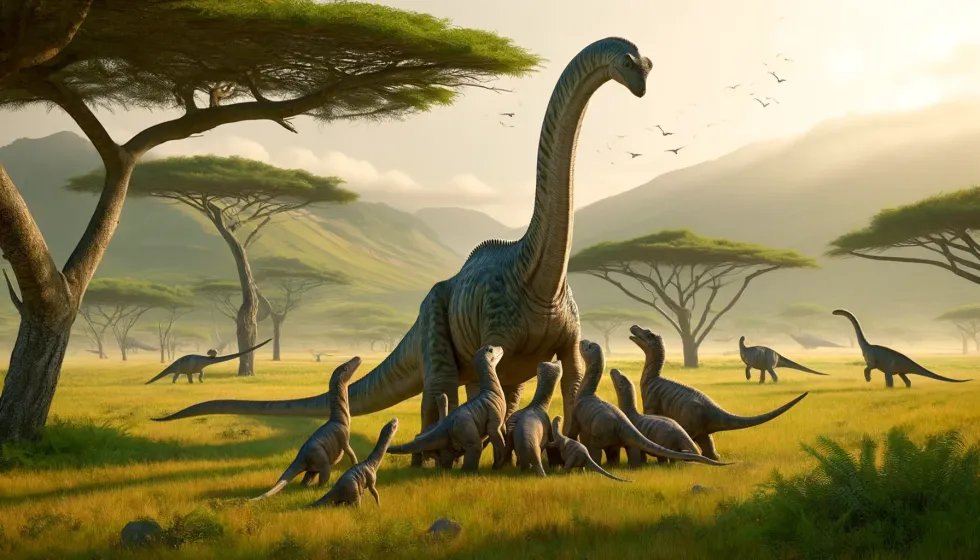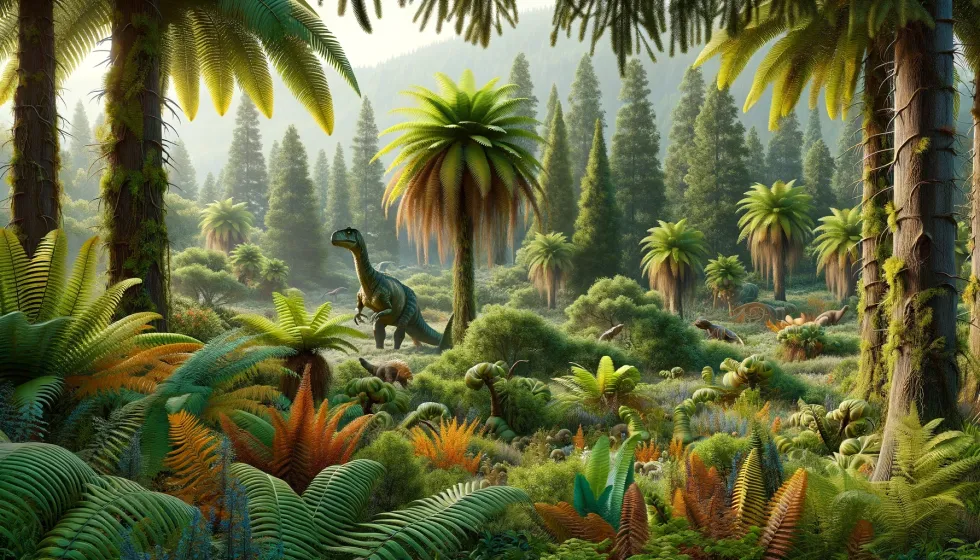Journey back in time to the Late Cretaceous Period (100.5-66 million years ago), when the mighty Aeolosaurus roamed the ancient landscapes. An intriguing member of the titanosaurs, this quadrupedal (walked on four legs) herbivore left behind a legacy etched in fossils, telling a story of life millions of years ago.
Aeolosaurus was a large and powerful four-legged dinosaur that could shape the landscape with its huge size. It's interesting to imagine what life would have been like in a world where such magnificent creatures roamed freely.
Read on to learn more about the giant Aeolosaurus and discover the wonders of the ancient past.
Aeolosaurus Interesting Facts
How do you pronounce 'Aeolosaurus'?
It's pronounced as 'ee-oh-loh-SAWR-us'.
What type of dinosaur was it?

Aeolosaurus was a titanosaurian sauropod dinosaur belonging to a distinct genus.
In which geological period did this dinosaur roam the Earth?
It lived during the Campanian to Maastrichtian stages (existing 83.6-66 million years ago) during the Late Cretaceous Period (100.5-66 million years ago).
When did the Aeolosaurus become extinct?
It became extinct by the end of the Maastrichtian age, about 66 million years ago.
Where did this dinosaur live?
The Aeolosaurus lived in what is now known as South America, with evidence of fossils in Argentina and Brazil.
What was their habitat?
Aeolosaurus likely lived in diverse habitats, including the woodlands and plains within the Cretaceous (existing 145-66 million years ago) fauna of Los Alamitos and the Bauru Group in Upper Cretaceous formations.
Who did they live with?

Aeolosaurus lived with other titanosaurs and potential predators, indicating a dynamic ecosystem with multiple species fulfilling diverse ecological roles, as is common with many sauropods, sharing the terrain with other Late Cretaceous fauna.
How long did this dinosaur live?
The lifespan of Aeolosaurus, a type of sauropod dinosaur, is still not fully understood, as there is limited information available on this particular species. However, based on the lifespan of other sauropod dinosaurs, it is estimated that Aeolosaurus could have lived for several decades.
These gentle giants were known for their towering height and large size, and were likely to have lived a long and slow-paced life, spending much of their time grazing on vegetation.
Future research and discoveries in the paleontological field may shed more light on the lifespan and other aspects of Aeolosaurus' biology.
How did they reproduce?
Aeolosaurus, a member of the sauropsid family of dinosaurs, is believed to have been an oviparous dinosaur, which means it laid eggs to reproduce, much like other reptiles.
However, there is limited information available about the specific characteristics of their egg clutches or nesting habits.
Further research is required to reveal more details about the reproductive biology of this intriguing dinosaur. With additional data, scientists may be able to better understand the unique adaptations of this species and how they were able to thrive in their environment.
Aeolosaurus Fun Facts
What did they look like?

They were massive dinosaurs with long necks and tails, bulky bodies, and relatively small heads. They had very distinctive caudal vertebrae (bones in the spine located towards the tail end of an animal's body) and are believed to have had osteoderms, which are protective bony plates in their skin like some of their titanosaur relatives.
How many bones did the Aeolosaurus have?

The full extent of its skeletal structure remains a mystery, with the exact number of bones in its complete skeleton yet to be determined.
However, it's known that they possessed a distinctive series of at least seven vertebrae in their tail, as well as a notable series of anterior and middle caudal vertebrae.
As the field of paleontology continues to advance, it is possible that further research may shed more light on this fascinating aspect of Aeolosaurus' anatomy.
How did they communicate?
No clear evidence is available from the Late Cretaceous Period regarding how Aeolosaurus, a type of sauropod dinosaur, communicated with one another.
However, scientists believe that they may have used a combination of sounds, body language, and visual displays to interact with their own species.
Further research and analysis of fossils and other evidence may provide more information on their behavior and communication methods.
How big was an Aeolosaurus?
It reached about 46–60 ft (14–18.1 m) in length.
How fast could this dinosaur move?
Based on the analysis of the limb bones, it has been inferred that the Aeolosaurus, a type of dinosaur that existed during the Late Cretaceous Period, did not possess exceptional speed.
The skeletal structure of this dinosaur suggests that it was adapted for a life on land and it is believed to have been a herbivorous dinosaur.
These findings provide valuable insights into the locomotion and lifestyle of this fascinating prehistoric creature.
How much did an Aeolosaurus weigh?
The estimated weight of this dinosaur differed by species and estimation method, but according to Molina-Pérez and Larramendi in 2020, the Aeolosaurus rionegrinus is thought to have weighed approximately 32,407 lb (14,706 kg).
What were the male and female names of the species?

Unlike many other dinosaur species, there are no distinct names for males and females of this species. Both genders were simply referred to as Aeolosaurus.
What would you call a baby Aeolosaurus?
When it hatches from its egg, it is considered a hatchling or a juvenile. At this stage of its life, it's much smaller than its adult counterparts and requires special care and protection.
As it grows and develops, it will gradually acquire an adult's physical and behavioral characteristics such as a long neck, a small head, and a herbivorous diet.
How aggressive were they?

These dinosaurs from the Late Cretaceous Period are believed to have been a herbivorous animals that fed on low-lying plants and vegetation. Based on its skeletal structure and the size of its bones, it is believed that this dinosaur was a quadruped that walked on all fours.
Although there is no concrete evidence to suggest whether it was an aggressive species or not, most paleontologists believe that it was a peaceful dinosaur that did not show signs of aggression towards other species unless provoked or threatened.
In fact, it is possible that it may have used its large, bony plates as a form of defense against predators, rather than as a means of aggression towards other animals.
Did You Know...
The Aeolosaurus rionegrinus' name was derived from the Greek words 'Aiolos', meaning 'quick' or 'nimble', and 'Saurus', meaning 'lizard'. The name might seem contradictory for such a large animal, but it perhaps refers to the genus's comparison with other, even larger sauropods.
Scientists found some important fossils of a type of dinosaur called Aeolosaurus in Los Alamitos, Patagonia, Argentina. These fossils show that this area was home to Aeolosaurus and other dinosaurs a long time ago.
Apart from Los Alamitos area, the Bauru Group located in the sedimentary rocks from the Upper Cretaceous period has been another important site for discovering Aeolosaurus fossils. Such sites offer critical proof of the dinosaur's existence and the environment it lived in.
The Aeolosaurus colhuehuapensis sp. is a species in the Aeolosaurus genus. This group's diversity adds to our knowledge of anatomy, behavior, and evolution, giving us a better understanding of their role in the prehistoric ecosystems of South America.
The presence of this dinosaur and its species, such as Aeolosaurus rionegrinus and Aeolosaurus colhuehuapensis, highlights the dynamic progression of life on Earth and the remarkable course of natural history.
The Brazilian Journal Of Geology, formerly the Revista Brasileira De Geociências, has featured research that enhances knowledge about the Aeolosaurus. It covers discoveries related to its structure, taxonomy, and ancient biology, such as reevaluations of the Aeolosaurus maximus and insights into its presence in Brazil.
Initially grouped with the Aeolosaurus genus, Aeolosaurus maximus was reclassified and moved to its unique genus, Arrudatitan, in 2021 due to its distinct features that set it apart from other Aeolosaurus species.
Discovered in the Angostura Colorada Formation in Argentina, dating from the Campanian stage of the Late Cretaceous Period, the holotype of Aeolosaurus rionegrinus consists of a series of seven tail vertebrae, as well as parts of both forelimbs and the right hindlimb.
The Aeolosaurus featured vertebral lateral fossae that resembled shallow depressions. These fossae, which similarly resemble shallow depressions, have also been observed in dinosaurs like Saltasaurus, Alamosaurus, Malawisaurus, and Gondwanatitan.
FAQs
How many species have been identified?
Paleontologists currently recognize at least two valid species, namely Aeolosaurus rionegrinus and Aeolosaurus maximus. Another possible species is Aeolosaurus colhuehuapensis.
When and where were the first fossils discovered?
The first Aeolosaurus fossils were discovered in 1987 in the Angostura Colorada Formation in Argentina.
Are there any distinctive features used to identify its fossils?
Aeolosaurus can be identified by its distinctive tail vertebrae, which have a characteristic downward curve and other unique skeletal features like the vertebral lateral fossae.
The Aeolosaurus, a quadrupedal herbivore, is a fascinating remnant of the Late Cretaceous Period, revealing the extensive diversity of dinosaur life. With the unearthing of Aeolosaurus fossils, researchers have reconstructed the narrative of these regal beings, enhancing understanding of the prehistoric world where they resided.
The presence of Aeolosaurus and its species, such as Aeolosaurus rionegrinus and Aeolosaurus colhuehuapensis, highlights the dynamic progression of life on Earth and the remarkable course of natural history.
Related Articles Around the Web


